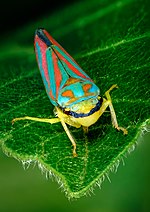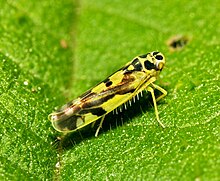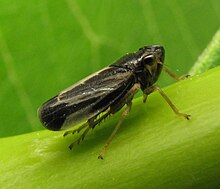Leafhopper
| Leafhoppers Temporal range:
| |
|---|---|

| |
| Adult two-lined gum treehoppers (Eurymeloides bicincta, Eurymelinae) with symbiotic meat ants | |
| Scientific classification | |
| Domain: | Eukaryota |
| Kingdom: | Animalia |
| Phylum: | Arthropoda |
| Class: | Insecta |
| Order: | Hemiptera |
| Suborder: | Auchenorrhyncha |
| Superfamily: | Membracoidea |
| Family: | Cicadellidae Latreille, 1802 |
| Subfamilies | |
|
24, see text | |

Leafhopper is the common name for any
The family is distributed all over the world, and constitutes the second-largest hemipteran family, with at least 20,000 described species.They belong to a lineage traditionally treated as
Members of the
Description and ecology

The Cicadellidae combine the following features:
- The thickened part of the antennae is very short and ends with a bristle (arista).
- Two ocelli(simple eyes) are present on the top or front of the head.
- The tarsi are made of three segments.
- The femora are at front with, at most, weak spines.
- The hind tibiae have one or more distinct keels, with a row of movable spines on each, sometimes on enlarged bases.
- The base of the middle legs is close together where they originate under the thorax.
- The front wings not particularly thickened.
An additional and unique character of leafhoppers is the production of brochosomes, which are thought to protect the animals, and particularly their egg clutches, from predation as well as pathogens.

Like other Exopterygota, the leafhoppers undergo direct development from nymph to adult without a pupal stage. While many leafhoppers are drab little insects as is typical for the Membracoidea, the adults and nymphs of some species are quite colorful. Some – in particular Stegelytrinae – have largely translucent wings and resemble flies at a casual glance.
Leafhoppers have
Leafhoppers are
In some cases, the plant pathogens distributed by leafhoppers are also
Some species such as the Australian Kahaono montana even build silk nests under the leaves of trees they live in, to protect them from predators.[8]
Systematics
In the now-obsolete classification that was used throughout much of the 20th century, the leafhoppers were part of the Homoptera, a

Within the latter, the three traditional
Subfamilies






The leafhoppers are divided into 25
- Aphrodinae
- Bathysmatophorinae
- Cicadellinae
- Coelidiinae
- Deltocephalinae
- Errhomeninae
- Euacanthellinae
- Eurymelinae
- Evacanthinae
- Hylicinae
- Iassinae
- Jascopinae
- Ledrinae
- Megophthalminae
- Mileewinae
- Nastlopiinae
- Neobalinae
- Neocoelidiinae
- Nioniinae
- Phereurhininae
- Portaninae
- Signoretiinae
- Tartessinae
- Typhlocybinae
- Ulopinae
- Further information: Agalliopsis, Utecha trivia
See also
References
- ^ a b Stiller, Michael (October–December 2009). "Biosystematics: Leafhoppers associated with grasslands of South Africa – Grassland Biome endemics" (PDF). Plant Protection News. 82: 6.[permanent dead link]
- ^ Sorensen, John T.; Campbell, Bruce C.; Gill, Raymond J. (1995). "Non-monophyly of Auchenorrhyncha ("Homoptera"), based upon 18S rDNA phylogeny: eco-evolutionary and cladistic implications within pre-Heteropterodea Hemiptera (s.l.) and a proposal for new monophyletic suborders". Pan-Pacific Entomologist. 71 (1): 31–60.
- S2CID 86564882.
- PMID 23445207.
- S2CID 36637453.
- PMID 24229807.

- PMID 16332205.
- .
- ^ a b David R. Maddison (January 1, 1995). "Hemiptera. True bugs, cicadas, leafhoppers, aphids, etc". Tree of Life Web Project. Retrieved August 24, 2010.
- ^ a b "Auchenorrhyncha". Tree of Life Web Project. January 1, 1995. Retrieved August 24, 2010.
- ^ a b "Membracoidea". Tree of Life Web Project. January 1, 1995. Retrieved August 24, 2010.
- ^ "Cicadellidae". 3I Interactive Keys and Taxonomic Databases. April 28, 2020.
Further reading
- Carver, M, FG. Gross, and TE. Woodward. 1991. Hemiptera (bugs, leafhoppers, cicadas, aphids, scale insects, etc.) In: The Insects of Australia – a Textbook for Students and Research Workers Volume 1. Melbourne University Press, Melbourne, Australia".
External links
 Data related to Cicadellidae at Wikispecies
Data related to Cicadellidae at Wikispecies Media related to Cicadellidae at Wikimedia Commons
Media related to Cicadellidae at Wikimedia Commons- Red-banded leafhopper Graphocephala coccinea – diagnostic photographs and information
- Illinois Natural History Survey:leafhoppers Archived 2015-04-17 at the Wayback Machine
- Leafhoppers of North and South America
- Sharpshooter Leafhoppers of the World (Hemiptera: Cicadellinae) – Online Database with color photos of nearly all described species.
- Leafhoppers Pinellas County Florida
- NMSU Entomology Plant Pathology; Weed Science. "New Mexico State University Carol Sutherland leafhopper collection". Archived from the original on 2013-05-01. Retrieved 2013-07-15.
- Auchenorrhyncha keys, Australia and neighbouring areas Archived 2016-07-18 at the Wayback Machine
- DrMetcalf: a resource on cicadas, leafhoppers, planthoppers, spittlebugs, and treehoppers
